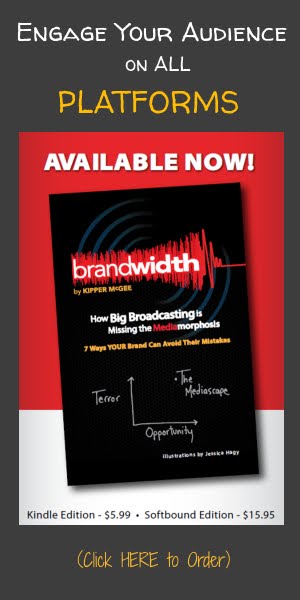Fast Forward Alert:
Does it seem like things are moving
faster these days? They ARE! The mediascape is changing. Is radio
listening?
More importantly, do broadcasters really
UNDERSTAND when, why and how consumers are using branded media content — or
are you among those stuck on the treadmill of “we’ve always/never done it that way”
thinking?
Few media brand managers have the time
and management support to effectively track the latest methods to break through
today’s communications clutter. Even fewer have the tools, staffing and
resources to really compete in our evolving 360 degree ‘Mediamorphosis’.
As an industry, we’ve been challenged to
deliver so much with so little for so long that the thought of tackling more
distribution channels is the LAST thing on most to-do lists.
Yet, your consumers are there. Can you
afford NOT to be?
As Dr. Roger Wimmer put it, the recipe
for winning is clear:
● Find out what consumers want from your
brand TODAY. (Also when, where and HOW!)
● Give it to Them
● TELL THEM that you’re giving it to them
(and “What’s In It For Them” if they select your brand(s)
The objectives are simple.
But not easy.
However, there is ONE ‘secret weapon’ which I
will share with you that you can implement TODAY to improve your branding while
making life LOTS easier!
The Great Equalizer
The GOOD news: every OTHER industry
faces the same challenges. The BAD news: For some reason, radio is clinging
past practices and outdated ‘group think’ more than most.
There is, however, one great equalizer
that separates winners from losers and leaders from followers. That Equalizer is TIME. Each of us has just 24
hours each day. The question is how well
we maximize this precious commodity.
When assisting clients, I recommend a
series of steps to make sure we’re building upon a strong foundation. For
matters of Branding, here are three of the most important:
● Brand Portfolio Management
● Asset Inventory
● Find Hidden Efficiencies
Creating
a Brand Portfolio Strategy
GM is a brand. But they also HAVE
subordinate brands like Cadillac, GMC, Buick and Chevrolet.
GM also has other brands like dealer
groups, individual dealers, financing and branded ‘original’ parts. The dealer
has any number of other brands, which may include service, individual sales
staff, an icon representative (like KFC has the Colonel), and others. Add in
all the OTHER automakers, and it’s easy to see how a strategy to manage all
these brands is critical.
In radio, most brand managers deal with
more than one station -- often in more than one market.
While each station brand should have an
overall “Marketing Model”, so should the various subordinate
brands like personalities, benchmark features, major on-air promotions, event
marketing and online platforms.
Remembering that we are all bound by
‘The Great Equalizer” of time, it is critical that there is a master plan of
how all these pieces fit together, and which ones get what level of priority.
The military uses the term “triage”, to
determine which battlefield cases can be saved, which can’t, and which can be
back-burnered until later.
The more you have a ‘triage plan’ in
place, the less time is wasted reinventing the same wheels. Ironically, the
more you have the predictable basics mapped out, the more flexible your time is
when some
urgent or hot opportunity arises!
Your Asset Inventory
Once you have put together your Brand
Portfolio Strategy, the next question is “how”?
Remember: as a brand manager, your
job is not to DO everything, but to make sure that IT GETS DONE!
That means taking inventory of all the
resources at your disposal and utilizing them wisely. Some places to look:
● Staffing. You may have a receptionist
who’s a social media maven, or an air talent with mad production skills. Pc may
be creating an opportunity of a lifetime simply by assessing who can do what,
and where their talents and desires may be hiding!
● Cluster/Group Dynamics. Old-school managers tend to think in a linear
fashion. If station “A” has an emerging
Photoshop Rembrandt on-air, perhaps that person can create online graphics for
stations “B” or “C”. Also, great talent
no longer need be limited to one market or cluster.
● Use the tools you have. There are many
great free resources for sharing information on a budget. Google Drive and
Evernote are just two of many.
Your Secret Weapon:
In my programming career, I’ve had the
good fortune of working with a variety or startups, turnarounds and heritage
stations.
One trick: regardless of format, I
always used music scheduling software like MusicMaster
to schedule promos and production elements — as well as the music.
This technique works with spoken word
formats, too. Scheduling promos helped
return WDBO/Orlando to #1 overall (and in all key demos)while helping
WLS-AM/Chicago beat longstanding leader WGN (and the Cubs!)in all dayparts and
demos under 65.
There are also ways this can be used to
enhance social media posts driving consumers to the distribution platform of
your choice. Especially handy in PPM and
Diary markets, if played right.
(This article originally appeared in
Musicmaster News #120 and is reprinted by permission)


